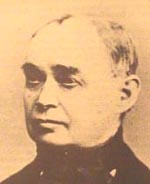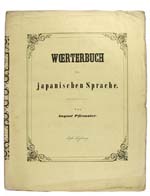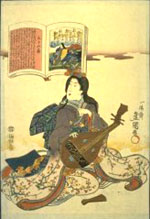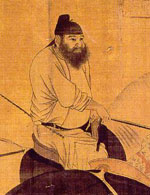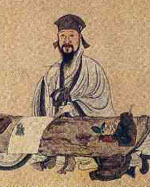Sinological Profiles
August Pfizmaier
17 March 1808 (Karlsbad) - 18 May 1887 (Vienna)
Oriental subjects had a slow beginning in Austria, and their early years are tales of few people and fewer resources. Michael Boym had published his Flora Sinensis in Vienna as early as 1656, but such events remained sporadic and exterior (Boym was then working as a missionary in Macao), and it was not until quite recent times that anything like depth in the study of Chinese or Japanese appeared in Austrian learned circles. Pfizmaier was one of the key figures. After a circuitous personal beginning, he found his way to the study of the Orient, and established a precedent, if not quite a foundation, for scholarly interest in both Japanese and Chinese. There would be no further significant construction at that site until a later age.
Pfizmaier was the son of an innkeeper in Karlsbad. After schooling in Prague and Pilsen, he took up the study of medicine, got his degree, and practiced medicine for a short period. In 1829 he first appeared in Viennese literary circles as the author of a brief poem of his own; in 1831 he published a translation of a Latin ode into Turkish. This to the astonishment of the local savants, who could not believe that a youth could have taught himself such things. In 1835, aged 27, and evidently in search of something further, he entered Charles University as a doctoral student in Theology. The following year he began the study of Arabic, which was not unusual for those whose studies required a knowledge of Hebrew. Two years after that, however, he went off in what can only have been an independent direction, and took up Oriental languages, relying, for Chinese, on the recently published though not infallible language guides of Abel-Remusat and Premare.
Here he finally found a life focus. In 1843 he was appointed Docent in Oriental Languages and Literatures at the University of Vienna. To mark his transition, he published in 1847 both a Turkish grammar (in which his knowledge of Arabic also came into play) and a first translation from Japanese, of a story printed in Edo in 1821 by Ryutei Tanehiko and illustrated by 57 woodblock prints by Toyokuni. Pfizmaier's version includes an introduction, the original kana text with his German translation, and monochrome versions of all 57 of the prints. This was the first Japanese text ever printed in Europe from movable types, the font having been cast in the previous year, at Pfizmaier's direction, for the Imperial printing office in Vienna.
In prompt recognition of this display of talent and enterprise, Pfizmaier was made a member of the Austrian Academy of Sciences in 1848. It was in the Proceedings and Memoirs of that Academy that nearly all his subsequent published work appeared. The Academy, far more than the University, was his intellectual home and his base of operations.
One task incumbent upon those who would establish an exotic literary discipline is to produce a dictionary of that language. Pfizmaier had previously set about to compile one which would far surpass any predecessor. Writing in English to a possible backer of the dictionary in 1845, and thus shortly before the appearance of his 1847 Sechs Wandschirme, Pfizmaier explained:
I therefore commenced to excerpt, for my own use, all the original lexicographical works of the Japanese within my reach, and by arranging alphabetically the words they contained, distributed according to subjects, I succeeded in setting down almost a complete dictionary; and with its help, I am now enabled to read Japanese books, though as yet with some trouble; exercise will, I hope, soon make my task an easier one. As to the characters, I can not only very pleasantly read them, but I have also engaged the Government printing-office to let cut the letters of the Firakana alphabets that are generally in use, so that Japanese works can now be printed at Vienna with moveable types. A specimen, consisting of a fragment of a Japanese romance, will, in a few weeks, leave the press, and I could now undertake the publication of whole texts, if the Government does not fear the expense. As to my dictionary, I need but translate the explanations into any European language (the Japanese authors themselves render them in Chinese), to have it ready for publication. I am still making additions, chiefly of words which I find in authors I am reading, so that it may be rendered as complete as possible. It contains, however, as it is, about 40,000 words, a number quite extraordinary, since the Vocabulary Japanese and English, by Medhurst, published at Batavia, 1830, only numbers 7,000, and that by Siebold, 1840, Leyden (with an arrangement by subjects, which makes it almost useless, and explanations chiefly in Chinese), contains little more than 20,000 words. I intend to publish mine as soon as any Government grants me favorable terms.
The phrase "words I find in authors I am reading" is significant. A sovereign cure for learning in isolation is to read a lot; to let the language impinge on you. If you have a critical mass of understanding to begin with, wide exposure will eventually teach you the rest. Such stratagems are not for the timid, but for those temperamentally capable of applying them, they work remarkably well. In years to come, Pfizmaier would range widely over early Japanese poetry and prose; among classical works, he left translations from the Ise Monogatari, the Izumi Shikibu Nikki, the Makura no Sôshi, and of course the Manyôshû.
Meanwhile, there remained the problem of paying for the printing of Pfizmaier's Japanese dictionary. A trip to the Netherlands to raise funds was given up, and with an initial subvention from Austria, a first portion of the dictionary, comprising its first 160 double pages (with characters and explanations on facing pages), appeared in 1851. The cost factor forced the abandonment of the project thereafter.
Pfizmaier's first study of the language of the Ainu appeared in 1851. Despite working from other people's wordlists, (and independently of Pott, a few years earlier, who had labored under the same difficulty), Pfizmaier was able to recognize the vigesimal nature of the counting system in that language. His Ainu studies were not an isolated or momentary whim, like Chamberlain's Ryûkyû; they continued to appear as late as 1883.
Like many in Europe, Pfizmaier was fascinated by the long persistence of the Chinese Empire. He turned to the Chinese dynastic histories for an explanation. His translations from those histories, and from poetry (the Chu Tsz; Tang poetry), most of them published by the Academy, eventually amounted to a substantial oeuvre. That oeuvre shows the inevitable weakness of working in isolation; in Pfizmaier's procedure, there was perhaps too much of the auto, and too little of the didact. Turner in 1851 noted his difficulties in preparing the Sechs Wandschirme of 1847:
In making this translation, Dr Pfizmaier had difficulties of various kinds to contend with. In the first place, so little had been hitherto done in Europe for the study of the Japanese, that he was obliged to construct his own aids as he went along, that is, beside deciphering the text, he had to compose a dictionary, and to divine most of the rules of the grammar. . . Yet, notwithstanding these difficulties, he thinks that he has furnished a translation tolerably free from faults, there being only a few isolated expressions with respect to which he is still in doubt, as to whether he has hit the right meaning. . .
Notwithstanding the pains bestowed by Dr Pfizmaier on his translation, it must be confessed that it is very obscure, and sometimes quite unintelligible; which without doubt is owing to the meagre nature of the helps at his command. Indeed, to render all the allusions perfectly intelligible to an Occidental reader, would require a body of annotation at least as large as the book itself. But for this the materials do not exist.
It is not enough to know the meanings of the words; one also has to understand the meaning of the meanings. And given the presence of the illustrations, so socially informative in their way, there is also the question of the meaning of the objects. Turner proceeds to explicate some details of the illustrations, referring to published works by Williams and von Siebold; that is, to things that had been available to Pfizmaier also.
His translations were sometimes a treacherous rather than a helpful guide for later scholars. Even so fallible a figure as Woitsch could make merry with the errors in Pfizmaier's poetry translations, and Yang Lien-sheng noted in a review that Needham had been misled at several points by Pfizmaier's translations from the Chinese histories. That peril continues: Al Cohen remarks "I've used Pfizmaier's translations from dynastic histories (as a rough guide only, since he too often goes off track)." They were nevertheless an important contribution to the acquaintance of one culture with another. Pfizmaier was also among the first European Sinologues to pay consecutive attention to Chinese Dauism, a subject which Maspero, in a later century, is sometimes credited with introducing. Pfizmaier's Japanese translations and studies, some of them very substantial, continued to appear alongside his Chinese ones for the whole of his career. So did some works which he signed with his medical degree, including a monograph on the longevity regimen of the Dauists. In 1874 he produced a work reminiscent of Boym's: an 87-page account of the Fruits of China. All this bespeaks an amazing breadth and energy, spread across the cultural and the material aspects of two major cultures (not counting Pfizmaier's contributions to Turkology), continued over a lifetime.
Up to the end, his work had its limitations. Pfizmaier's crowning achievement in Chinese literature was probably his book on Bwo Jyw-yi, the Chinese poet most admired in Japan, which appeared the year before his death. He was attracted to these poems for qualities he himself noted: their simplicity and beauty, and, as he felt, their freedom from complications which would require a learned commentary. This sensibly chosen material he rendered word-for-word into German. But as Bernhard Führer has recently noted:
Doch gerade in Pfizmaiers Streben nach wortgetreuer Wiedergabe und Nachahmung der chinesischen Satzstellung liegt eine der offensichtlichsten Schwächen seiner Übersetzungen. Durch seine Herangehensweise werden die poetischen Bilder oft genug verdeckt und der Sinn entstellt. Sowohl in seiner Auswahl als auch in den Übersetzungen zeigt er eine etwas unglückliche Hand. Pfizmaiers Blütenlese spiegelt mehr seine eigene Lebenssituation wider, als sie die Vorzüge des dichterischen Werks Bai Juyis zu illustrieren vermag. Gerade jene einfacheren, von literarischen Anspielungen weitgehend unbelasteten Gedichte, auf die seine Beschreibung des poetischen Werks Bei Juyis bezogen werden muss, hat Pfizmaier in seine Auswahl nicht aufgenommen.
von Zach, while reproving Woitsch for his unseemly glee at pointing out Pfizmaier's mistakes, himself devoted some journal space to correcting errors in Pfizmaier's Bwo Jyw-yi. The unspoken point, here, is that in one way or another Pfizmaier's work was continuing to supply a need, fifty years after his death.
For all of Pfizmaier's talent and energy, it seems that the bottom line must be negative. His dictionary quickly outran his budget; his translations repeatedly overtaxed his competence. His teaching had little discernible impact: he had few students, and left essentially no tradition. He was a pioneer in whose wake no city was founded. He died in 1887, shortly after the construction of a new Main Hall for the University of Vienna. The Sinological structure was yet to come. The 1897 verdict of Cordier ran thus:
The death of Pfizmaier . . . has left vacant a place easy to fill, for this scholar was more remarkable for the number than for the value of his publications.
But there is perhaps a little more to it than that. Pfizmaier left Austria more widely aware than it had previously been of what had been done and felt by the major civilizations of the furthest East. He took Japan out of the curiosa category. He brought it close, and he gave it charm. And he did so with considerable skill; Roy Andrew Miller has pointed out, with an acidity worthy of von Zach on a good day, that Pfizmaier's Japanese poetry translations will at least now and then stand comparison with the 20th century's best. His Chinese history translations opened the door to what had happened in China, and let readers wander around inside large tracts of it. If his work had no immediate successor, and stood as an isolated monument, it remains a very substantial monument.
And by publishing his findings from the highest official circles, he implicitly demonstrated that it was Austria's proper business to take a hand in further exploring those horizons. Austria's later shortcomings in so doing cannot properly be charged to Pfizmaier. He made what start he could.
References
- August Pfizmaier. Sechs Wandschirme in Gestalten der vergänglichen Welt. 1847
- August Pfizmaier. Notiz über das geschichtswerk Tso-tschuen. 1850
- William W Turner. Account of a Japanese Romance. JAOS v2 (1851) 27-54. A synopsis of the story of the Sechs Wandschirme, meant as an aid to its readers.
- August Pfizmaier. Woerterbuch der japanischen Sprache. Gerold 1851
- August Pfizmaier. Untersuchungen über dan Bau der Aino-Sprache. 1951
- August Pfizmaier. Abhandlungen über die Aino-Sprache. 1952
- August Pfizmaier. Kritische Durchsicht der von Dawidow verfassten Wörtersammlung aus der Sprache der Aino's. 1852.
- August Pfizmaier. Beitrag zur Kenntniss de ältesten japanischen Poesie. 1852
- August Pfizmaier. Über einige Eigenschaften der japanischen Volkspoesie. 1852
- August Pfizmaier. Das Li-sau und die neun Gesänge. 1852
- August Pfizmaier. Vocabularium der Aino-sprache. 1854
- August Pfizmaier. Die Geschichte des Reiches U. 1857
- August Pfizmaier. Geschichte des Hauses Tschao. 1858
- August Pfizmaier. Die Chinesische Lehre von den Kreisläufen und Luftarten. 1869
- August Pfizmaier. Die poetischen Ausdrücke der japanischen Sprache. 2v 1873-1874
- August Pfizmaier. Über japanische Archaismen. 1874
- August Pfizmaier. Denkwürdigkeiten von den Früchten China's. Gerold 1874
- August Pfizmaier. Der Feldzug der Japaner gegen Corea im jahre 1597. 1876
- August Pfizmaier. Die Geschichte einer Seelenwanderung in Japan. Gerold 1877
- August Pfizmaier. Der Nebel der Klage: ein japanisches Zeitbild. 2v 1877-1878. Translation of a work by Takizawa Bakin
- August Pfizmaier. Die Geschichte einer Seelenwanderung in Japan. 2v 1877-1878 (translation of Hida no Takumi Monogatari by Ishikawa Masamochi)
- August Pfizmaier. Zur Geschichte der Aufstände gegen das Haus Sui. Gerold 1878
- August Pfizmaier. Der Stand der chinesischen Geschichtschreibung in dem Zeitalter der Sung. 1878
- August Pfizmaier. Darlegung der chinesischen Ämter. 2v 1879-1880
- August Pfizmaier. Zwei Reisen nach dem westen Japans in den Jahren 1369 und 1389 n Chr. 1882
- August Pfizmaier. Lebensbeschreibungen von heerführern und würdenträgern des Hauses Sui. 1882
- August Pfizmaier. Nachrichten aus der Geschichte der nördlichen Thsi. 1884
- August Pfizmaier. Erklärung des tagebuches Idzmi-siki-bu. 1885
- M Dr August Pfizmaier. Analecta aus der chinesischen Pathologie. 1886
- August Pfizmaier. Der chinesische Dichter Pe-lo-thien. Gerold 1888
- Berthold Laufer. The Vigesimal and Decimal Systems in the Ainu Numerals. JAOS v37 (1917) 192-208
- Richard L Walker. August Pfizmaier's Translataions from the Chinese. JAOS v69 #4 (1949) 215-223. A finding list of the sources of Pfizmaier's translations from the dynastic histories.
- Hartmut Walravens. August Pfizmaier. [Hamburg] Bell 1984. A bibliography
- Peter Pantzer. August Pfizmaier 1808-1887: Katalog. [Vienna] Literas 1987
- Otto von Ladstätter and Sepp Linhart (ed). August Pfizmaier (1808-1887) und seine Bedeutung für die Ostasien Wissenschaften. Österrichische Akademie der Wissenschaften 1990. It is in this volume that the essay by Roy Andrew Miller appears.
- Bernhard Führer. Vergessen und Verloren. Projekt 2001. For Pfizmaier see p59-72
Al Cohen and Tim Wixted contributed to this profile.
22 Jan 2008 / Contact The Project / Exit to Sinology Page

